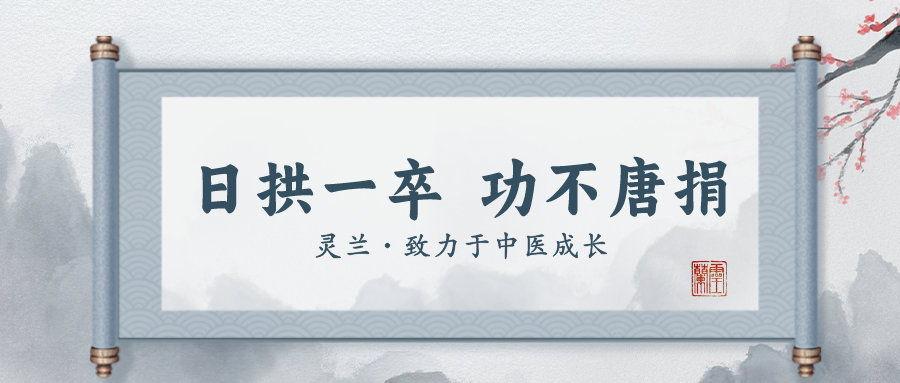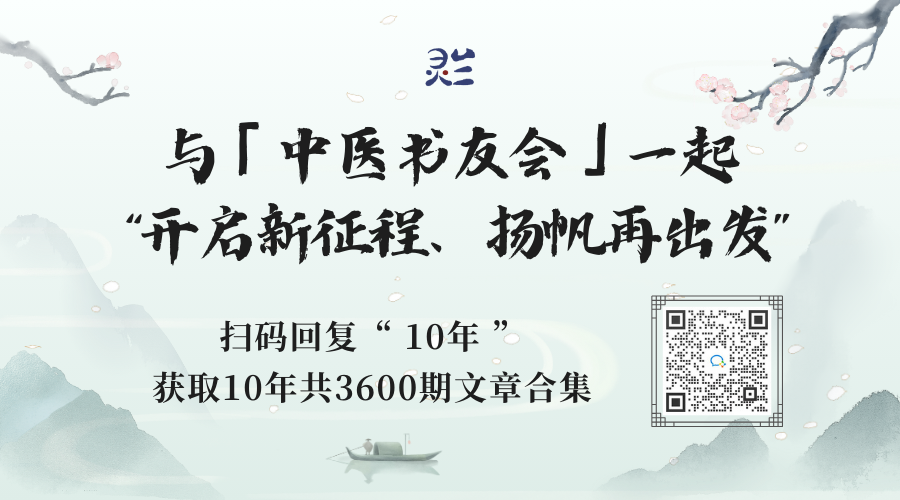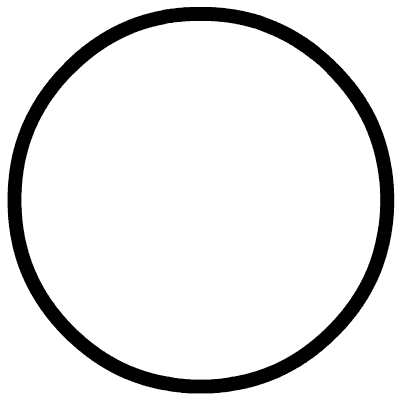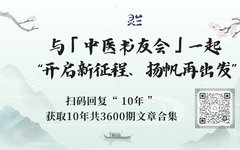

TCM Book ClubIssue 3874One issue daily, accompanying the growth of TCM practitioners
IIntroduction: To treat edema, one cannot avoid the three major methods—open the ghost gate, cleanse the residence, and eliminate the stagnant phlegm. The theory of invigorating blood and promoting diuresis has been recognized early in TCM, yet it is often overlooked, with the common practice being to treat water with water. In what circumstances should we consider invigorating blood and promoting diuresis? This article presents three medical cases to illustrate.
—This article is approximately2200words, expected reading time6minutes—

Water and blood are important components of bodily fluids. Under physiological conditions, blood circulates within the vessels, while water accumulates outside the vessels, with both permeating and supporting each other; under pathological conditions, they can influence each other. When blood circulation is obstructed or stagnated, it often leads to abnormal water metabolism, resulting in edema, distension, phlegm retention, turbidity, and dampness accumulation. The ‘Essentials of the Golden Chamber’ summarizes this as “when blood is not smooth, it becomes water“. For treatment, one should not simply treat water with water, but rather invigorate blood to address the root cause; when blood is active, water-related issues will resolve on their own. Below are three cases that apply this method.Case 1: Edema During MenstruationHuang, female, 32 years old, first diagnosed on August 3, 1995.The patient reports that since January 1995, her menstrual flow has been very scant, stopping within a day. She suffers from full-body swelling and edema during menstruation, with eyelid swelling in the morning and abdominal distension making it difficult to bend. The edema naturally subsides after menstruation, but recurs with the next cycle.She has taken over ten prescriptions of Chinese medicine without improvement. The prescriptions she took were primarily for strengthening the spleen, tonifying the kidneys, and promoting diuresis. Now, with menstruation approaching, the edema has returned.Examination: Heart and lung X-rays, urine, and blood tests are all normal. The tongue is pale with a thin white coating, and the pulse is deep and wiry. This indicates stagnation during menstruation, with blood transforming into water. The treatment should invigorate blood and unblock menstruation; when menstruation is smooth, water will naturally dissipate.Modified Gui Zhi Fu Ling WanGui Zhi 10g, Xiang Fu 12g, Chuan Xiong 12g, Dang Gui 12g, Chi Shao 12g, Yi Mu Cao 20g, Ze Lan 15g, Tao Ren 12g, Hong Hua 12g, Dan Pi 12g, Dan Shen 20g, Fu Ling 12g. Decoction, one dose every other day, for 3 doses.
Second diagnosis on August 10: After taking the medicine, the menstrual flow increased significantly, and the full-body edema reduced by more than half. After adjusting the formula and taking 2 more doses, the edema completely resolved.Since then, the menstrual flow has been normal, and there has been no further edema..
Comment
Zhang Yin’an in his ‘Huangdi Neijing Ling Shu’ states:“The blood and qi within the vessels permeate from the collaterals to the outside; the blood and qi outside the vessels flow back into the vessels through the collaterals, allowing for mutual exchange.”
This means that blood and water can transform into each other. In this patient, the edema occurs during menstruation, characterized by scant menstrual flow and a deep, wiry pulse, indicating that the edema is due to obstructed menstrual flow and stagnant blood. The excess “blood and qi within the vessels” leads to excessive permeation outside the vessels, thus general water treatment is ineffective. Therefore, we treat blood instead of water, ensuring smooth menstrual flow without stagnation, preventing excessive permeation of “blood and qi within the vessels” outside, leading to rapid resolution of edema without recurrence.Case 2: Blood Ascites (Budd-Chiari Syndrome)
Kong, male, 56 years old, retired teacher, admitted to the TCM ward on June 20, 1988.
The patient has experienced abdominal distension since early 1986, which developed into a large abdomen resembling a drum six months later, with visible veins, decreased urine output, and lower limb edema in the afternoon, but normal appetite and no weight loss.Multiple liver function tests have been normal.This May, an ultrasound at the provincial hospital showed:enlarged and thickened liver and spleen.Venography revealed portal vein varices with signs of blood stasis, confirming the diagnosis of Budd-Chiari syndrome. The patient is unwilling to undergo surgical treatment.
Examination:The patient has cyanosis of the lips and face, skin of the limbs is rough, severe ascites, abdominal circumference 102 cm, and lower limb edema with pitting. The tongue is dark purple with a thin white coating, and the pulse is wiry, large, and forceful.This indicatesstagnant blood within the liver and spleen meridians, with obstruction in the San Jiao, causing water and qi to accumulate. The treatment should invigorate blood and break stasis to unblock the water pathways.
Modified Xia Yu Xue TangDan Shen 30g, Kun Bu 30g, Ze Lan 15g, Tao Ren 12g, Hong Hua 12g, San Leng 10g, E Zhu 10g, Chi Shao 12g, Xiang Fu 12g, Tu Bie Chong 12g, Jiu Da Huang 12g, San Qi powder 6g (dissolved). Decoction, one dose daily, for 6 doses with a day of rest.Additionally, use Da Huang Zhe Chong Wan, 1 pill (6g) three times a day.
After taking about 30 doses of the above formula, abdominal distension significantly reduced, with abdominal circumference decreasing to about 90 cm, cyanosis of the lips and face disappeared, skin of the limbs became soft like a normal person, and lower limb edema also decreased significantly.By the time 60 doses were taken, abdominal distension had reduced by more than half, and there was no more lower limb edema, with the patient feeling much more agile.
Comment
The patient’s ascites appeared as if water was the disease, but in reality, it was due to stagnant blood accumulating in the liver and spleen, obstructing the meridians, causing qi transformation to be obstructed, and the water and fluids in the San Jiao to be unable to circulate, leading to fluid retention and the onset of ascites.If one treats water with water, it will certainly be ineffective.
Now, using the method of invigorating blood to treat water, with a focus on breaking stasis and dispersing accumulations, along with the addition of Da Huang Zhe Chong Wan, which gradually disperses stagnant blood, we specifically target blood stasis. After more than two months of treatment, although a complete cure was not achieved, significant effects were observed in controlling disease progression and alleviating and eliminating some symptoms.
Case 3: Menstrual Cessation with Increased Vaginal Discharge
Liu, female, 21 years old, unmarried, first diagnosed on March 1, 1993.
The patient reported that half a year ago, during menstruation, she worked in water, and the next day her menstruation ceased. Soon after, she experienced increased vaginal discharge.In the past month, the discharge has worsened, occurring day and night, thick and sticky, with a strong fishy odor, accompanied by a hard, descending sensation in the lower abdomen, and soreness in the lower back and knees, with poor appetite and fatigue.She has taken Bai Dai Wan, Wu Ji Bai Feng Wan, and antibiotics multiple times, but the discharge has not decreased at all.Ultrasound and gynecological examinations at this hospital showed no abnormalities.
The tongue is pale with a thin white coating, and the pulse is deep, tight, and wiry.This indicatescold dampness invading the uterus, causing menstrual flow to be obstructed and transforming into water. The treatment should warm the meridians, invigorate blood, and unblock menstruation; when menstruation is unblocked, the discharge will cease.
Modified Shao Fu Zhu Yu TangSheng Pu Huang 10g, Wu Ling Zhi 10g, Dang Gui 12g, Chuan Xiong 12g, Xiang Fu 12g, Rou Gui 8g, Dan Shen 30g, Yi Mu Cao 24g, Chao Bai Zhu 12g, Fu Ling 18g, Chi Shao 12g, Yan Hu Suo 12g, Shu Di Huang 30g, Chuan Niu Xi 12g. Decoction, one dose every other day, for 3 doses.
Second diagnosis on March 8:After taking 3 doses, menstruation resumed, and vaginal discharge significantly decreased, with the lower abdomen no longer feeling hard.After adjusting the formula and continuing for 2 more doses, the patient was cured.
CommentThis patient had menstrual cessation first, followed by increased discharge, indicating that the discharge is a transformation of the menstrual blood that has not been expelled, which is distinctly different from other forms of discharge.
This aligns perfectly with the description in the ‘Essentials of the Golden Chamber: Women’s Miscellaneous Diseases and Pulse Diagnosis’ stating that “when women have menstrual cessation and the organs are firm, there is stagnant blood, leading to white discharge.”
Since the root cause is blood (menstrual cessation) and the manifestation is water (discharge), the treatment with Shao Fu Zhu Yu Tang warms the meridians and breaks stasis, specifically addressing the menstrual flow, thus achieving the remarkable effect of stopping the discharge without directly treating it.
 Recommended Reading Zhen Wu Decoction with the “Three Methods to Treat Water” for Congestive Heart Failure Understand the “Eight Methods to Invigorate Blood” for Treating Blood Stasis, don’t miss this article
Recommended Reading Zhen Wu Decoction with the “Three Methods to Treat Water” for Congestive Heart Failure Understand the “Eight Methods to Invigorate Blood” for Treating Blood Stasis, don’t miss this article
—Copyright Statement—
• This article is excerpted from the ‘Henan Journal of Traditional Chinese Medicine’ (2001) | Author/Zhang Yuchen• Duty Editor/Wang Qinli | Proofreader/Shouwang | Recommended by/Yang Zhishi | Typesetting/Song Qu | Visuals/Shisan | Introduction/Yi Yi | Review/Ju Ye.• The copyright of this article belongs to the rights holder. For educational exchange only, please do not self-medicate.

 Click here to download the Linglan TCM app
Click here to download the Linglan TCM app

